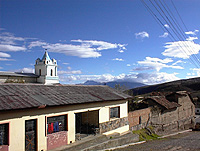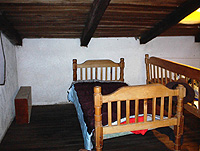
View Cangahua from our door
Hacienda Guachala

My dormant crevice
|
|
|
July 14, 2002
Chilling in Cangahua
Last night was the first night that inaugurated
our project. The participant in this program gathered at Jardin
Del Sol hotel. We went out to dinner and get acquainted.
Afterward, we returned to the hotel and had another get together, this time
over drinks. I made mojitos (Cuban cocktail) and served everyone.
I’ve been warned not to drink for the first few days there due to the attitude
change. But then who can postpone joy. And true to the advice,
I felt slow in the morning.
I went out for a last minute shopping spree before leaving
for Cangahua this morning. This little town at the foot of Volcano
Cayambe was the site of our base camp. There weren’t
much amenities around there. Cangahua was so small and reclusive,
even some Ecuadorians didn’t know where it was.
The bus rolled off Quito around 11:00am and attacked the
sierra then headed north toward the town Cayambe. Cayambe was
our window to the world. It has a market, internet café and
restaurant. It even has a western style grocery store. On the
equator line, we turned south toward Cangahua. The first stop was Hacienda
Guachala. The first-class passengers get to stay at the Hacienda.
This historical place was visited by dignitaries like presidents of
Ecuador and famous personality like Edward Whymper who was the first
Westerner to climb the Cayambe. According to an author,
Guachala, the region, was concreted by Inca king Huyana Capac
in 1500 as he ordered the fortresses to be built in the region of Pambamarca.
The bus, after dropping the first-class group off at the
Hacienda, continued climbing the slope toward a barren
land. Adobe houses bloomed on the sides of the road. Gardens
of leaks and potatoes speckled throughout the land. The bus
finally rolled into a town center. A plaza appeared in front of us.
In the middle, a group of local children surrendered a few gringos.
These missionaries passed out goodies in plastic bags and appeared to play
"duck-duck-goose". The evangelical people penetrated deep into Ecuador.
In Quito, I saw a group of gringos holding orphans kids in the park and cried
while praying together.
While other people’s interest laid elsewhere, this
area, believed by Dr. S. C., the project leader, as the site of heavy
fighting during the Incas reign. Dr. C interested in finding evidence
of the Cayambis society- a warlike group of people that fought the Incas
for 19 years. Dr. C. discovered Cangahua couple years
back when he came and met Don Carlito. An elder and the representative
mayor of the town, Don Carlito was all happy to meet a bonafide archeologist
from the States. Don Carlito claimed to be the purveyor of the Cayambis.
He wrote a book on the indigenous group but remained unpublished.
Dr. C and Don Carlito went on a hike to the site. It
was so strenuous, he almost died after that day. Don Carlito was a
jolly guy. He came in on the first day to deliver a speech on his welcoming.
The Don maintained that this is their land and they are the straight descendants
of the Cayambis. No Inca had ever given them culture. They
had their own. Our presence seemed to be an added incentive to his
passion as he was willingly to provide all the moral, political and mental
supports to the group.
From the bus stop, we trekked a short climb to
the town’s community housing ran by the church under the command of El
Padre. El Padre (the father), not only a religious leader, he was
the sheriff of Cangahua. He demanded such respect from the local, a
mere mentioned of his name would pop the peasants' ears. Stepping
through the low doorway, we entered a building made of stucco and wood.
The floor was of green linoleum and the wall was painted in an off
white color.
A flight of stair led us up to our dormitory on the second
floor. The stair whined with each creak crying a bit louder when we
walked on it. Flanking on both sides of the next hall were two rows
of wooden beds. These sunlight windows provided the morning sun, but
they were also a nuisance. The openings were covered with corrugated
plastic roof, therefore each night the cold air invited itself to our
room through the cracks. And since the insulation system in
this house hasn’t been conceptualized, the vicious wind of Cangahua
found our shivering feet as helpless victims.
|
|